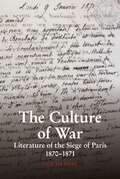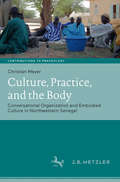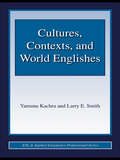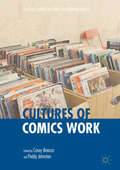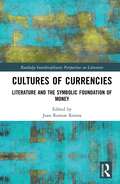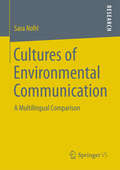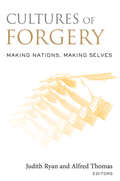- Table View
- List View
The Culture of Usury in Renaissance England
by D. HawkesThis book examines the ways in which usury was perceived and portrayed as it rose to popularity in Renaissance England, taking into account the works of key literary figures of this period, including Milton and Shakespeare.
The Culture of War: Literature of the Siege of Paris 1870-1871 (Studies in Modern and Contemporary France #6)
by Colin FossThe Culture of War explores the unexpected flourishing of literature both high and low during the Siege of Paris at the end of the Franco-Prussian War, 1870-1871. When Prussian forces completely blockaded Paris, isolating the city from the outside world, Parisians turned to literature to resist the enemy, to fill the idle hours under siege, and to articulate their place in history. This cultural boom was a conscious effort on the part of literary institutions like newspapers, publishers, and theaters to ensure the viability of their industries during a period of political uncertainty. To do so, many publishers, editors, and directors sought legitimacy through populism, promoting literature written by anonymous and unknown authors or that spoke to populist ideas. A study of national tragedy on a local scale, The Culture of War goes beyond traditional narratives of communal or individual psychology, and studies institutional responses to financial and political instability, viewing literature as a product of economic and political forces.
The Culture of Yellow: Or, The Visual Politics of Late Modernity
by Sabine DoranThis is the first book to explore the cultural significance of the color yellow, showing how its psychological and aesthetic value marked and shaped many of the intellectual, political, and artistic currents of late modernity. It contends that yellow functions during this period primarily as a color of stigma and scandal.Yellow stigmatization has had a long history: it goes back to the Middle Ages when Jews and prostitutes were forced to wear yellow signs to emphasize their marginal status. Although scholars have commented on these associations in particular contexts, Sabine Doran offers the first overarching account of how yellow connects disparate cultural phenomena, such as turn-of-the-century decadence (the "yellow nineties"), the rise of mass media ("yellow journalism"), mass immigration from Asia ("the yellow peril"), and mass stigmatization (the yellow star that Jews were forced to wear in Nazi Germany). The Culture of Yellow combines cultural history with innovative readings of literary texts and visual artworks, providing a multilayered account of the unique role played by the color yellow in late nineteenth- and twentieth-century American and European culture.
The Culture of Yellow: Or, The Visual Politics of Late Modernity
by Sabine DoranThis is the first book to explore the cultural significance of the color yellow, showing how its psychological and aesthetic value marked and shaped many of the intellectual, political, and artistic currents of late modernity. It contends that yellow functions during this period primarily as a color of stigma and scandal.Yellow stigmatization has had a long history: it goes back to the Middle Ages when Jews and prostitutes were forced to wear yellow signs to emphasize their marginal status. Although scholars have commented on these associations in particular contexts, Sabine Doran offers the first overarching account of how yellow connects disparate cultural phenomena, such as turn-of-the-century decadence (the "yellow nineties"), the rise of mass media ("yellow journalism"), mass immigration from Asia ("the yellow peril"), and mass stigmatization (the yellow star that Jews were forced to wear in Nazi Germany). The Culture of Yellow combines cultural history with innovative readings of literary texts and visual artworks, providing a multilayered account of the unique role played by the color yellow in late nineteenth- and twentieth-century American and European culture.
Culture, Practice, and the Body: Conversational Organization and Embodied Culture in Northwestern Senegal (Beiträge zur Praxeologie / Contributions to Praxeology)
by Christian MeyerHuman sociality is shaped and realized most notably in embodied practices of interpersonal interaction. At the same time, the social nature of human beings is open for cultural influences. This book inspects the foundations of human sociality theoretically drawing on recent debates in sociology, anthropology, and linguistics, and empirically by the example of interactions on the central square of a Wolof village in Northwestern Senegal.Menschliche Sozialität gestaltet und realisiert sich zuallererst in den vielfältigen verkörperten Praktiken zwischenmenschlicher Interaktionen. Die Sozialnatur des Menschen ist dabei offen für kulturelle Einflüsse. Dieses Buch inspiziert die Grundlagen menschlicher Sozialität theoretisch anhand jüngerer Diskussionen in der Soziologie, Ethnologie, Anthropologie und Linguistik und empirisch am Beispiel von Interaktionen auf dem zentralen Platz eines Dorfes der Wolof Nordwestsenegals.
Culture Wars in American Education: Past and Present Struggles Over the Symbolic Order (Critical Social Thought)
by Michael R. OlneckCulture Wars in American Education: Past and Present Struggles Over the Symbolic Order radically questions norms and values held within US Education and analyses why and how culture wars in American education are intense, consequential, and recurrent.Applying the concept of “symbolic order,” this volume elaborates ways in which symbolic representations are used to draw boundaries, allocate status, and legitimate the exercise of authority and power within American schooling. In particular, the book illustrates the “terms of inclusion” by which full membership in the national community is defined, limited, and contested. It suggests that repetitive patterns in the symbolic order, for example, the persistence of the representation of an individualistic basis of American society and polity, constrain the reach of progressive change. The book examines the World War I era Americanization movement, the World War II era Intercultural Education movement, the late-twentieth-century Multicultural Education movement, continuing right-wing assaults on Ethnic Studies and Critical Race Theory in the first decades of the twenty-first century, and historical and contemporary conflicts over the incorporation of languages other than Standard English into approved instructional approaches.In the context of continuing culture wars in the United States and across the globe, this book will be of interest to graduate students and scholars in critical studies of education, history of education, sociology of education, curriculum theory, Multicultural Education, and comparative education, as well as to educators enmeshed in contemporary tensions and conflicts.
Culture Wars in American Education: Past and Present Struggles Over the Symbolic Order (Critical Social Thought)
by Michael R. OlneckCulture Wars in American Education: Past and Present Struggles Over the Symbolic Order radically questions norms and values held within US Education and analyses why and how culture wars in American education are intense, consequential, and recurrent.Applying the concept of “symbolic order,” this volume elaborates ways in which symbolic representations are used to draw boundaries, allocate status, and legitimate the exercise of authority and power within American schooling. In particular, the book illustrates the “terms of inclusion” by which full membership in the national community is defined, limited, and contested. It suggests that repetitive patterns in the symbolic order, for example, the persistence of the representation of an individualistic basis of American society and polity, constrain the reach of progressive change. The book examines the World War I era Americanization movement, the World War II era Intercultural Education movement, the late-twentieth-century Multicultural Education movement, continuing right-wing assaults on Ethnic Studies and Critical Race Theory in the first decades of the twenty-first century, and historical and contemporary conflicts over the incorporation of languages other than Standard English into approved instructional approaches.In the context of continuing culture wars in the United States and across the globe, this book will be of interest to graduate students and scholars in critical studies of education, history of education, sociology of education, curriculum theory, Multicultural Education, and comparative education, as well as to educators enmeshed in contemporary tensions and conflicts.
Culture Writing: Literature and Anthropology in the Midcentury Atlantic World (Modernist Literature and Culture)
by Tim WatsonFocusing on the 1950s and early 1960s, Culture Writing argues that this period in Britain, the United States, France, and the Caribbean was characterized by dynamic exchanges between literary writers and anthropologists on both sides of the Atlantic. As the British and French empires collapsed and the United States rose to global power in the early Cold War, and as intellectuals from the decolonizing world challenged the cultural hegemony of the West, some anthropologists began to assess their discipline's complicity with empire and experimented with literary forms and technique. Culture Writing shows that the "literary turn" in anthropology took place earlier than has conventionally been assumed, in the 1950s rather than the 1970s and 80s. Simultaneously, some literary writers reacted to the end of the period of modernist experimentation by turning to ethnographic methods for representing the people and cultural practices of Britain, France, and the United States, bringing anthropology back home. There is analysis of literary writers who had a significant professional engagement with anthropology and brought some of its techniques and research questions into literary composition: Barbara Pym (Britain), Ursula Le Guin and Saul Bellow (United States), Édouard Glissant (Martinique), and Michel Leiris (France). On the side of ethnography, the book analyzes works by anthropologists who either explicitly or surreptitiously adopted literary forms for their writing about culture: Laura Bohannan (United States), Michel Leiris and Claude Lévi-Strauss (France), and Mary Douglas (Britain). Culture Writing concludes with an epilogue that shows how the literature-anthropology conversation continues into the postcolonial period in the work of Indian author-anthropologist Amitav Ghosh and Jamaican author-sociologist Erna Brodber.
Culture Writing: Literature and Anthropology in the Midcentury Atlantic World (Modernist Literature and Culture)
by Tim WatsonFocusing on the 1950s and early 1960s, Culture Writing argues that this period in Britain, the United States, France, and the Caribbean was characterized by dynamic exchanges between literary writers and anthropologists on both sides of the Atlantic. As the British and French empires collapsed and the United States rose to global power in the early Cold War, and as intellectuals from the decolonizing world challenged the cultural hegemony of the West, some anthropologists began to assess their discipline's complicity with empire and experimented with literary forms and technique. Culture Writing shows that the "literary turn" in anthropology took place earlier than has conventionally been assumed, in the 1950s rather than the 1970s and 80s. Simultaneously, some literary writers reacted to the end of the period of modernist experimentation by turning to ethnographic methods for representing the people and cultural practices of Britain, France, and the United States, bringing anthropology back home. There is analysis of literary writers who had a significant professional engagement with anthropology and brought some of its techniques and research questions into literary composition: Barbara Pym (Britain), Ursula Le Guin and Saul Bellow (United States), Édouard Glissant (Martinique), and Michel Leiris (France). On the side of ethnography, the book analyzes works by anthropologists who either explicitly or surreptitiously adopted literary forms for their writing about culture: Laura Bohannan (United States), Michel Leiris and Claude Lévi-Strauss (France), and Mary Douglas (Britain). Culture Writing concludes with an epilogue that shows how the literature-anthropology conversation continues into the postcolonial period in the work of Indian author-anthropologist Amitav Ghosh and Jamaican author-sociologist Erna Brodber.
Cultures and Literatures in Dialogue: The Narrative Construction of Russian Cultural Memory (Routledge Studies in Nineteenth Century Literature)
by Elena BollingerThis book addresses the narrative construction of Russian cultural memory in the work of Julian Barnes. It investigates how Barnes's texts tend to display a memory process as a transcultural mode of the creation of English and Russian national identities. Examining a need to revisit Russian canonical works, the detailed discursive analysis of the selected English texts exposes an intertextual remembering by duplication, thus contributing to the prevention of forgetting through the recuperation of still misrecollected cultural meanings. By creatively incorporating Russian intertextual elements into his work as a novelist, the author seems to insist on sweeping across and beyond national boundaries, revealing how frail the invention of tradition is when leading to the illusion of a solid collective memory and its political legitimation. The book considers not only a constructive dialogue between Barnes’s fiction and Russian classical literature, but also this writer’s interpretative, mostly imaginative, integration of Russian literature and culture into his work as a novelist. Exploring the double meaning of a literary metaphor as a mnemonic image of memory and a product of imagination, it offers a comprehensive analysis of Barnes’s texts which play with intertextuality as an efficient tool of displacement of official memory, providing a deeper understanding of historical and cultural processes related to the constantly moving architecture of transcultural memory.
Cultures and Literatures in Dialogue: The Narrative Construction of Russian Cultural Memory (Routledge Studies in Nineteenth Century Literature)
by Elena BollingerThis book addresses the narrative construction of Russian cultural memory in the work of Julian Barnes. It investigates how Barnes's texts tend to display a memory process as a transcultural mode of the creation of English and Russian national identities. Examining a need to revisit Russian canonical works, the detailed discursive analysis of the selected English texts exposes an intertextual remembering by duplication, thus contributing to the prevention of forgetting through the recuperation of still misrecollected cultural meanings. By creatively incorporating Russian intertextual elements into his work as a novelist, the author seems to insist on sweeping across and beyond national boundaries, revealing how frail the invention of tradition is when leading to the illusion of a solid collective memory and its political legitimation. The book considers not only a constructive dialogue between Barnes’s fiction and Russian classical literature, but also this writer’s interpretative, mostly imaginative, integration of Russian literature and culture into his work as a novelist. Exploring the double meaning of a literary metaphor as a mnemonic image of memory and a product of imagination, it offers a comprehensive analysis of Barnes’s texts which play with intertextuality as an efficient tool of displacement of official memory, providing a deeper understanding of historical and cultural processes related to the constantly moving architecture of transcultural memory.
Culture's Consequences: Comparing Values, Behaviors, Institutes and Organizations across Nations (The Macat Library)
by Katherine ErdmanThe Dutch anthropologist Geert Hofstede is recognized as a pioneer in the fields of international management and social psychology – and his work is a perfect example of the ways in which interpretative skills can help solve problems and provide the foundation for strong thinking and understanding both in business and beyond. Hofstede’s central achievement was setting up an efficient interpretative framework for understanding the cultural differences between one country and another. Working for the international computing company IBM in the late 1960s, Hofstede noted that such cultural differences had huge consequences for international organizations. Up until then, while many inside and outside of business recognized the importance of these differences, little had been done to define precisely what cultural difference was and in what areas of life it was expressed. Hofstede’s insight was that if one could interpret and define the dimensions of cultural difference, it would be possible to measure them and act accordingly. From a vast survey of IBM’s employees in several countries, Hofstede originally defined five dimensions of culture: every society could be rated for each dimension, providing a useful guide to the kinds of cultural differences at play. As ever, good interpretative skills provided the basis for better understanding.
Culture's Consequences: Comparing Values, Behaviors, Institutes and Organizations across Nations (The Macat Library)
by Katherine ErdmanThe Dutch anthropologist Geert Hofstede is recognized as a pioneer in the fields of international management and social psychology – and his work is a perfect example of the ways in which interpretative skills can help solve problems and provide the foundation for strong thinking and understanding both in business and beyond. Hofstede’s central achievement was setting up an efficient interpretative framework for understanding the cultural differences between one country and another. Working for the international computing company IBM in the late 1960s, Hofstede noted that such cultural differences had huge consequences for international organizations. Up until then, while many inside and outside of business recognized the importance of these differences, little had been done to define precisely what cultural difference was and in what areas of life it was expressed. Hofstede’s insight was that if one could interpret and define the dimensions of cultural difference, it would be possible to measure them and act accordingly. From a vast survey of IBM’s employees in several countries, Hofstede originally defined five dimensions of culture: every society could be rated for each dimension, providing a useful guide to the kinds of cultural differences at play. As ever, good interpretative skills provided the basis for better understanding.
Cultures, Contexts, and World Englishes
by Yamuna Kachru Larry E. SmithThis volume aims to familiarize readers with the varieties of world Englishes used across cultures and to create awareness of some of the linguistic and socially relevant contexts and functions that have given rise to them. It emphasizes that effective communication among users of different Englishes requires awareness of the varieties in use and their cultural, social, and ideational functions. Cultures, Contexts and World Englishes: demonstrates the rich results of integrating theory, methodology and application features critical and detailed discussion of the sociolinguistics of English in the globalized world gives equal emphasis to grammar and pragmatics of variation and to uses of Englishes in spoken and written modes in major English-using regions of the world. Each chapter includes suggestions for further reading and challenging discussion questions and appropriate research projects designed to enhance the usefulness of this volume in courses such as world Englishes, English in the Global Context, Sociolinguistics, Critical Applied Linguistics, Language Contact and Convergence, Ethnography of Communication, and Crosscultural Communication.
Cultures, Contexts, and World Englishes
by Yamuna Kachru Larry E. SmithThis volume aims to familiarize readers with the varieties of world Englishes used across cultures and to create awareness of some of the linguistic and socially relevant contexts and functions that have given rise to them. It emphasizes that effective communication among users of different Englishes requires awareness of the varieties in use and their cultural, social, and ideational functions. Cultures, Contexts and World Englishes: demonstrates the rich results of integrating theory, methodology and application features critical and detailed discussion of the sociolinguistics of English in the globalized world gives equal emphasis to grammar and pragmatics of variation and to uses of Englishes in spoken and written modes in major English-using regions of the world. Each chapter includes suggestions for further reading and challenging discussion questions and appropriate research projects designed to enhance the usefulness of this volume in courses such as world Englishes, English in the Global Context, Sociolinguistics, Critical Applied Linguistics, Language Contact and Convergence, Ethnography of Communication, and Crosscultural Communication.
Cultures in Conversation (Routledge Communication Series)
by Donal CarbaughCultures in Conversation introduces readers to the ethnographic study of intercultural and social interactions through the analysis of conversations in which various cultural orientations are operating. Author Donal Carbaugh presents his original research on conversation practices in England, Finland, Russia, Blackfeet County, and the United States, demonstrating how each is distinctive in its communication codes--particularly in its use of symbolic meanings, forms of interaction, norms, and motivational themes. Examining conversation in this way demonstrates how cultural lives are active in conversations and shows how conversation is a principal medium for the coding of selves, social relationships, and societies. Representing 20 years of research, this volume offers unique insights into the ways social interactions not only gain shape from, but also are formative of cultures. It makes a significant contribution to communication scholarship, and will be illuminating reading in courses focusing on cultural communication, language and social interaction, intercultural pragmatics, and linguistics.
Cultures in Conversation (Routledge Communication Series)
by Donal CarbaughCultures in Conversation introduces readers to the ethnographic study of intercultural and social interactions through the analysis of conversations in which various cultural orientations are operating. Author Donal Carbaugh presents his original research on conversation practices in England, Finland, Russia, Blackfeet County, and the United States, demonstrating how each is distinctive in its communication codes--particularly in its use of symbolic meanings, forms of interaction, norms, and motivational themes. Examining conversation in this way demonstrates how cultural lives are active in conversations and shows how conversation is a principal medium for the coding of selves, social relationships, and societies. Representing 20 years of research, this volume offers unique insights into the ways social interactions not only gain shape from, but also are formative of cultures. It makes a significant contribution to communication scholarship, and will be illuminating reading in courses focusing on cultural communication, language and social interaction, intercultural pragmatics, and linguistics.
Cultures of Comics Work (Palgrave Studies in Comics and Graphic Novels)
by Casey Brienza Paddy JohnstonThis anthology explores tensions between the individualistic artistic ideals and the collective industrial realities of contemporary cultural production with eighteen all-new chapters presenting pioneering empirical research on the complexities and controversies of comics work. Art Spiegelman. Alan Moore. Osamu Tezuka. Neil Gaiman. Names such as these have become synonymous with the medium of comics. Meanwhile, the large numbers of people without whose collective action no comic book would ever exist in the first place are routinely overlooked. Cultures of Comics Work unveils this hidden, global industrial labor of writers, illustrators, graphic designers, letterers, editors, printers, typesetters, publicists, publishers, distributors, translators, retailers, and countless others both directly and indirectly involved in the creative production of what is commonly thought of as the comic book. Drawing upon diverse theoretical and methodological perspectives, an international and interdisciplinary cohort of cutting-edge researchers and practitioners intervenes in debates about cultural work and paves innovative directions for comics scholarship.
Cultures of Compunction in the Medieval World (New Directions in Medieval Studies)
by Graham Williams Charlotte SteenbruggeCompunction was one of the most important emotions for medieval Christianity; in fact, through its confessional function, compunction became the primary means for an affective sinner to gain redemption. Cultures of Compunction in the Medieval World explores how such emotion could be expressed, experienced and performed in medieval European society. Using a range of disciplinary approaches – including history, philosophy, art history, literary studies, performance studies and linguistics – this book examines how and why emotions which now form the bedrock of modern western culture were idealized in the Middle Ages. By bringing together expertise across disciplines and medieval languages, this important book demonstrates the ubiquity and impact of compunction for medieval life and makes wider connections between devotional, secular and quotidian areas of experience.
Cultures of Compunction in the Medieval World (New Directions in Medieval Studies)
by Graham Williams Charlotte SteenbruggeCompunction was one of the most important emotions for medieval Christianity; in fact, through its confessional function, compunction became the primary means for an affective sinner to gain redemption. Cultures of Compunction in the Medieval World explores how such emotion could be expressed, experienced and performed in medieval European society. Using a range of disciplinary approaches – including history, philosophy, art history, literary studies, performance studies and linguistics – this book examines how and why emotions which now form the bedrock of modern western culture were idealized in the Middle Ages. By bringing together expertise across disciplines and medieval languages, this important book demonstrates the ubiquity and impact of compunction for medieval life and makes wider connections between devotional, secular and quotidian areas of experience.
Cultures of Currencies: Literature and the Symbolic Foundation of Money (Routledge Interdisciplinary Perspectives on Literature)
by Joan Ramon ResinaThis book’s premise is not only the commonly accepted cultural relativity of economic concepts, but also the observation that the current shift in the meaning of concepts like “market,” “currency,” “exchange,” and “money” suggests that culture is undergoing a change with unpredictable economic and political consequences. The essays in the book raise basic questions concerning exchange – what is exchanged, who exchanges and how, which kind of currency is used, and indeed what is money and how does it convey and retain value over time. These issues are all classical objects of economic theory, but less often have they been approached from a cultural perspective. Works treating economic and monetary issues from a cultural perspective are few and far apart, and this book aims to contribute to such a perspective with a variety of approaches.
Cultures of Currencies: Literature and the Symbolic Foundation of Money (Routledge Interdisciplinary Perspectives on Literature)
by Joan Ramon ResinaThis book’s premise is not only the commonly accepted cultural relativity of economic concepts, but also the observation that the current shift in the meaning of concepts like “market,” “currency,” “exchange,” and “money” suggests that culture is undergoing a change with unpredictable economic and political consequences. The essays in the book raise basic questions concerning exchange – what is exchanged, who exchanges and how, which kind of currency is used, and indeed what is money and how does it convey and retain value over time. These issues are all classical objects of economic theory, but less often have they been approached from a cultural perspective. Works treating economic and monetary issues from a cultural perspective are few and far apart, and this book aims to contribute to such a perspective with a variety of approaches.
Cultures of Economy in South-Eastern Europe: Spotlights and Perspectives (Edition Kulturwissenschaft #220)
by Jurij Murasov Davor Beganovic Andrea LesicThe ubiquitous »cultural turn« of the 1990s did not spare the thinkers of economics - however, at the same time, economic topics have gained a new importance in cultural studies. This volume focuses on cultures of economy in regions of former Yugoslavia as part of South-Eastern Europe, supported by theoretical perspectives. It examines narratives and poetics of economy in literature, film, and art, as well as in public discourse. The contributors spotlight different historical periods: the late 19th and the early 20th centuries, Socialist Yugoslavia and the transitional and neoliberal period since the 1990s.
Cultures of Environmental Communication: A Multilingual Comparison
by Sara NofriSara Nofri combines several research methods (multilingual bibliographic research, quantitative content analysis, semiotic text analysis, interviews to journalists) and a cross-cultural, interdisciplinary perspective for investigating environmental communication in the daily quality press of Germany, Italy, Sweden and UK. She provides an in-depth portrait of the features, the focus, the themes and stakeholders involved, individuates different "cultures of environment" and "cultures of communication", and provides insights and practical tools to analyze and then evaluate environmental communication. The methodological approach of this study can be readily transposed to studies investigating other contexts, cultures and media.
Cultures of Forgery: Making Nations, Making Selves (CultureWork: A Book Series from the Center for Literacy and Cultural Studies at Harvard)
by Judith Ryan Alfred ThomasIn Cultures of Forgery, leading literary studies and cultural studies scholars examine the double meaning of the word "forge"-to create or to form, on the one hand, and to make falsely, on the other.

